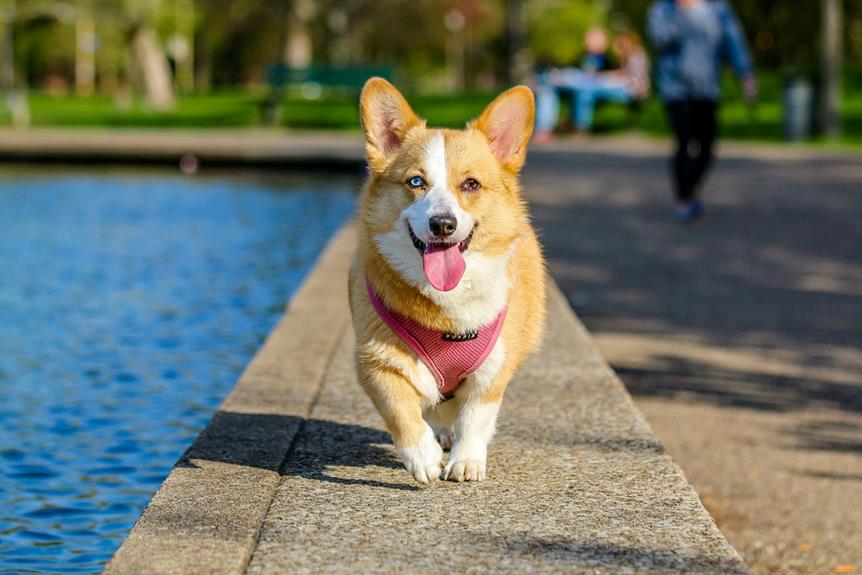
When deciding on the ideal dog leash for your specific breed, it's crucial to take into consideration various factors such as size, strength, behavior, and training. The leash you choose can significantly impact your control and your furry companion's safety during walks. But how do you know which leash is truly the best fit for your dog? By understanding your breed's unique characteristics and exploring the range of leash types available, you can make a well-informed decision that enhances your daily walks.
Understanding Your Breed's Size and Strength
When choosing a dog leash, consider your breed's size and strength to ensure safe and effective handling. Larger and stronger breeds, such as German Shepherds or Rottweilers, require sturdy and durable leashes that can withstand their power. Opt for a leash made from materials like nylon or leather, as they offer both strength and reliability.
For medium-sized breeds like Border Collies or Cocker Spaniels, a leash with medium thickness and flexibility is ideal. This allows for a good balance between control and comfort during walks. Look for a leash that's lightweight yet durable to accommodate your dog's energy levels.
Smaller breeds such as Chihuahuas or Pomeranians need a leash that's lightweight and easy to manage. A thin, retractable leash can provide them with the freedom to explore while still maintaining control. Additionally, consider the handle of the leash, ensuring it's comfortable for your grip during longer walks.
Considering Your Dog's Behavior and Training
Consider your dog's behavior and training to choose a leash that complements their personality and responsiveness during walks.
If your dog is well-trained and walks calmly by your side, a standard leash may suffice. However, if your furry friend tends to pull or gets easily distracted, a shorter leash or a hands-free leash could provide more control. Dogs that are prone to chewing or pulling may benefit from a sturdy, chew-resistant leash to ensure safety and longevity.
Additionally, consider the level of training your dog has undergone. A well-trained dog may respond well to verbal cues and gentle leash corrections, while a less obedient pup might require a leash with extra features like padded handles or reflective strips for better control and visibility during nighttime walks.
Tailoring the leash to your dog's behavior and training level can help make walks more enjoyable for both of you.
Exploring Different Leash Types and Materials
To better cater to your dog's needs, familiarize yourself with the various types of leashes and materials available for a more tailored walking experience.
When choosing a leash, consider factors such as your dog's size, behavior, and the walking environment. Retractable leashes provide flexibility for dogs who enjoy exploring, but they may not be suitable for strong pullers.
Standard nylon leashes are durable and come in various lengths, making them versatile for different breeds. Leather leashes are sturdy and stylish, ideal for well-trained dogs that don't pull excessively. For dogs with sensitive skin, consider a padded leash to prevent discomfort during walks.
Reflective leashes are excellent for nighttime visibility, ensuring safety during evening strolls. Chain leashes offer extra strength for large or powerful breeds, but they can be heavy and may not be comfortable for smaller dogs.
Tips for Testing and Adjusting Leash Fit
Ensure your dog's comfort and safety by properly testing and adjusting the fit of their leash. Start by checking that the leash isn't too loose or too tight around your dog's neck. You should be able to fit two fingers between the leash and your dog's neck to ensure a secure yet comfortable fit. When testing the leash fit, make sure it doesn't slip off easily but isn't so tight that it restricts your dog's movement or causes discomfort. Additionally, observe your dog's behavior when wearing the leash. If they seem uncomfortable, try adjusting the fit until they appear at ease.
To adjust the leash fit, most leashes come with adjustable features such as clips, buckles, or sliders. Experiment with these adjustments until you find the right fit for your dog. It's crucial to regularly check and readjust the leash fit as your dog grows or if you switch to a different leash. Remember, a properly fitted leash ensures both your dog's safety and comfort during walks and activities.




